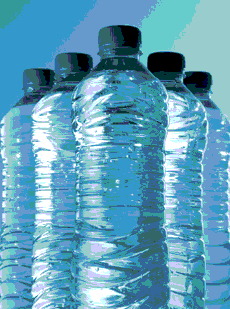Bottled love could douse goals
 Over a million bottles of water are sold around the world every minute, and according to the UN.
Over a million bottles of water are sold around the world every minute, and according to the UN.
A report from the United Nations University Institute for Water says the dramatic rise of the bottled water industry is helping mask a failure of public systems in many parts of the world to supply reliable drinking water, forcing their populations to seek it elsewhere.
Based on an analysis of literature and data from 109 countries, the report says that in just five decades bottled water has developed into “a major and essentially standalone economic sector,” experiencing 73 per cent growth from 2010 to 2020. Sales are expected to almost double by 2030, from US$270 billion to $500 billion.
The report by UN University’s Canadian-based Institute for Water, Environment and Health concludes that the unrestricted expansion of the bottled water industry “is not aligned strategically with the goal of providing universal access to drinking water or at least slows global progress in this regard, distracting development efforts and redirecting attention to a less reliable and less affordable option for many, while remaining highly profitable for producers”.
Kaveh Madani, UNU-INWEH’s new Director, says; “The rise in bottled water consumption reflects decades of limited progress in and many failures of public water supply systems”.
When the Sustainable Development Goals were agreed in 2015, he notes, experts elsewhere estimated an annual investment of US$114 billion was needed from 2015 to 2030 to achieve a key target: universal safe drinking water.
The report says providing safe water to the roughly 2 billion people without it would require an annual investment of less than half the US$270 billion now spent every year on bottled water.
“This points to a global case of extreme social injustice, whereby billions of people worldwide do not have access to reliable water services while others enjoy water luxury,” he said.
The study quotes surveys showing bottled water is often perceived in the Global North as a healthier and tastier product than tap water - more a luxury good than a necessity.
In the Global South, sales are driven by the lack or absence of reliable public water supplies and water delivery infrastructure limitations due to rapid urbanisation.
In mid- and low-income countries, bottled water consumption is linked to poor tap water quality and often unreliable public water supply systems - problems often caused by corruption and chronic underinvestment in piped water infrastructure.
Beverage corporations are adept at marketing bottled water as a safe alternative to tap water by drawing attention to isolated public water system failures, says UNU-INWEH researcher and lead author Zeineb Bouhlel, adding that “even if in certain countries piped water is or can be of good quality, restoring public trust in tap water is likely to require substantial marketing and advocacy efforts”.
The source of bottled water (municipal system, surface, etc.) the treatment processes used (e.g. chlorination, ultraviolet disinfection, ozonation, reverse osmosis), the storage conditions (duration, light exposure, temperature), and packaging (plastic, glass), can all potentially alter water quality.
This may be inorganic (e.g. heavy metals, pH, turbidity etc.), organic (benzene, pesticides, microplastics, etc.) and microbiological (pathogenic bacteria, viruses, fungus and parasitic protozoa).
According to the report, “the mineral composition of bottled water can vary significantly between different brands, within the same brand in different countries, and even between different bottles of the same batch”.
The report lists examples from over 40 countries in every world region of contamination of hundreds of bottled water brands and all bottled water types.
“This review constitutes strong evidence against the misleading perception that bottled water is an unquestionably safe drinking water source,” says Dr Bouhlel.
With respect to the industry’s environmental impacts, the report says there is “little data available on water volumes extracted”, largely due to the lack of transparency and legal foundation that would have forced bottling companies to disclose that information publicly and assess the environmental consequences.
“Local impacts on water resources may be significant,” the report says.
In the USA, for example, Nestlé Waters extracts 3 million litres a day from Florida Springs; in France, Danone extracts up to 10 million litres a day from Evian-les-Bains in the French Alps; and in China, the Hangzhou Wahaha Group extracts up to 12 million litres daily from Changbai Mountains springs.
Regarding plastic pollution, the researchers cite estimates that the industry produced around 600 billion plastic bottles and containers in 2021, which converts to some 25 million tonnes of PET waste - most of it not recycled and destined for landfills - a mass of plastic equal to the weight of 625,000 40-ton trucks, enough to form a bumper-to-bumper line from New York to Bangkok.
According to the report, the bottled water sector used 35 per cent of the PET bottles produced globally in 2019; 85 per cent wind up in landfills or unregulated waste.
By country, the USA is the largest bottled water market, with around US$64 billion in sales, followed by China (almost US$45 billion) and Indonesia (US$22 billion). Together, these three countries constitute almost half of the world market.
Other top countries by sales include Canada, Australia, Singapore, Germany, Thailand, Mexico, Thailand, Italy, Japan.
The average cost of a bottle of water in North America and Europe is around US$2.50, more than double the price in Asia, Africa and Latin American and Caribbean (LAC) ($0.80, $0.90 and $1, respectively). Australia, the fifth largest market, has the highest average price: $3.57 per unit.
The full report is accessible here.








 Print
Print